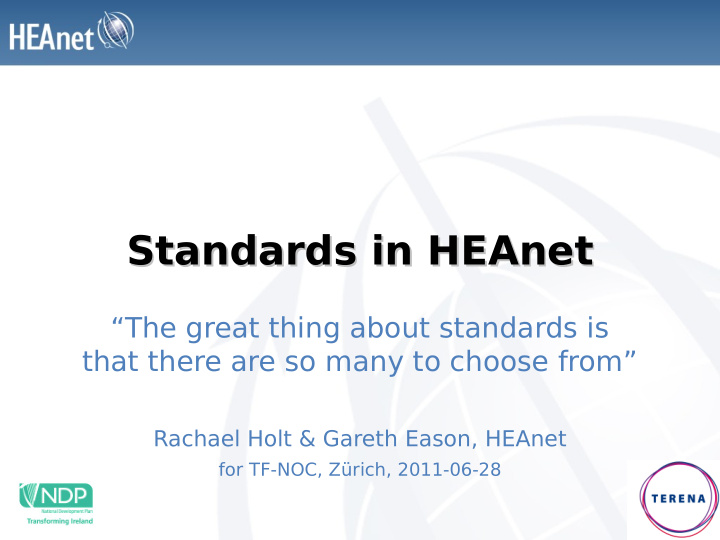



Standards in HEAnet Standards in HEAnet “The great thing about standards is that there are so many to choose from” Rachael Holt & Gareth Eason, HEAnet for TF-NOC, Zürich, 2011-06-28
Agenda • Advantages of standards? • What standards? • HEAnet & standards • Hurdles & Disadvantages • Lessons learned • Next steps
Who are HEAnet? • HEAnet is Ireland's research and education network (NREN) • Set up in 1983 as a collaborative body by the seven Irish universities and the Higher Education Authority • Became a non-profit, limited company in 1997 • Approximately 50 staff serving 180,000+ end-users
What do we do? • Provide high quality Internet services to our members • Enable research and learning through leading edge shared services • Act as a representative body for the ICT education & research community • Facilitate innovation & collaboration • Ensure value for money
What do we do? • Provide high quality Internet services to our members • Enable research and learning through leading edge shared services • Act as a representative body for the ICT education & research community • Facilitate innovation & collaboration • Ensure value for money
Affiliations & Representations National • IBEC – TIF/Telecoms Internet Federation • INEX/Internet Neutral Exchange • ISPAI / Internet Service Provider Association of Ireland International • EU funded Framework Projects • RIPE Network Co-ordination Centre (NCC) • DANTE/TERENA (37 countries) • GÉANT/NREN Consortium Policy Committee • JANET (UK) and JANET-CERT • MoU with Internet 2/ NGI
Advantages of standards? • Ability to collaborate • Communicate using standard nomenclature / vocabulary • Measurability of consistency & quality • Comparability • External verification • Auditability (client audits)
Advantages of standards? • Internal processes can be based on standards – Saves us having to write from scratch – Learn good practice from others – Good standards are maintained • Standards are only a guide – You must write your own processes
Advantages of standards?
What standards? • ISO 9000 • ISO 20000 • BS 7799 / ISO 17799 • ITIL • OSSTMM • eTOM • DPA (& other legislation / guidelines)
HEAnet viewpoint • Standards group formed to examine: – ITIL – ISO – Other relevant standards – Recommend what HEAnet should do • Report delivered April 2010 – Examined ISO20000 & ITIL – Recommended examining ITIL first – then ISO 20000 (with some exceptions)
HEAnet viewpoint We are here
Hurdles • Staff resistance • Cost (of certification & training) • Existing procedures • Management buy-in • Complexity • Client resistance to change • Lack of perceived benefit
Piecemeal approach • ISO 17799 (BS 7799) – Used by security team – Capable of auditing client installations to standard – Useful for client security audits • Cannot further accredit – HEAnet staff would require additional training & certification – Only a limited # of staff qualified.
Piecemeal approach • ISO 14064 – Carbon gas emissions – Direct & Indirect – HEAnet carbon production measured & validated (audited) • Purpose: – 2010: Measure Carbon emissions – 2011: Reduce Carbon emissions – 2012: Continuous improvement – Green Star network project
Likelihood of fixing problem (relative) 10 20 30 40 50 60 70 0 N O C N M C T h i r d L i n e S u p p o r t ITIL “Service Desk” Most likely to fix problem S e c o n d L i n e S u p p o r t (by name alone) S u p p o r t D e s k I T I L S e r v i c e D e s k S e r v i c e D e s k F i r s t L i n e S u p p o r t C a l l D e s k
Likelihood of fixing problem (relative) 10 20 30 40 50 60 70 0 N O C N M C T h i r d L i n e S u p p o r t ITIL “Service Desk” Most likely to fix problem S e c o n d L i n e S u p p o r t (by name alone) S u p p o r t D e s k I T I L S e r v i c e D e s k S e r v i c e D e s k F i r s t L i n e S u p p o r t C a l l D e s k
ITIL “Service Desk” • ITIL 'Service Desk' rename abandoned
Piecemeal approach • Change management processes – Request for change in writing – Change approval process • Continuous Service Improvement – Pervades all processes & client contact – incl. SLA agreement & requirements gathering
Data Protection • Legislation as a type of standard – HEAnet work with ISPAI, Government, Clients, etc. • Telecommunications (Data Retention Act) 2011 – EU directive 2006/24/EC
Lessons learned • Hurdles are real! • Lots of cost (time & resource) to implement • Management must buy in • A little at a time / piecemeal approach works well • Staying ahead of customer needs is vital
Next steps • Evaluate eTOM with ITIL • Evaluate ICASA • Continue ITIL 'good practice': – Review and continuous improvement of services – Look for other low-hanging fruit • Review management and client 'buy‑in' • Continue sharing & learning from other NRENs and their experiences
Your next steps? • Hurdles? • Cost (time & resource)? • Management buy in? • Piecemeal approach? Wholistic? • Customer opinions? • What are you doing about standards?
Recommend
More recommend